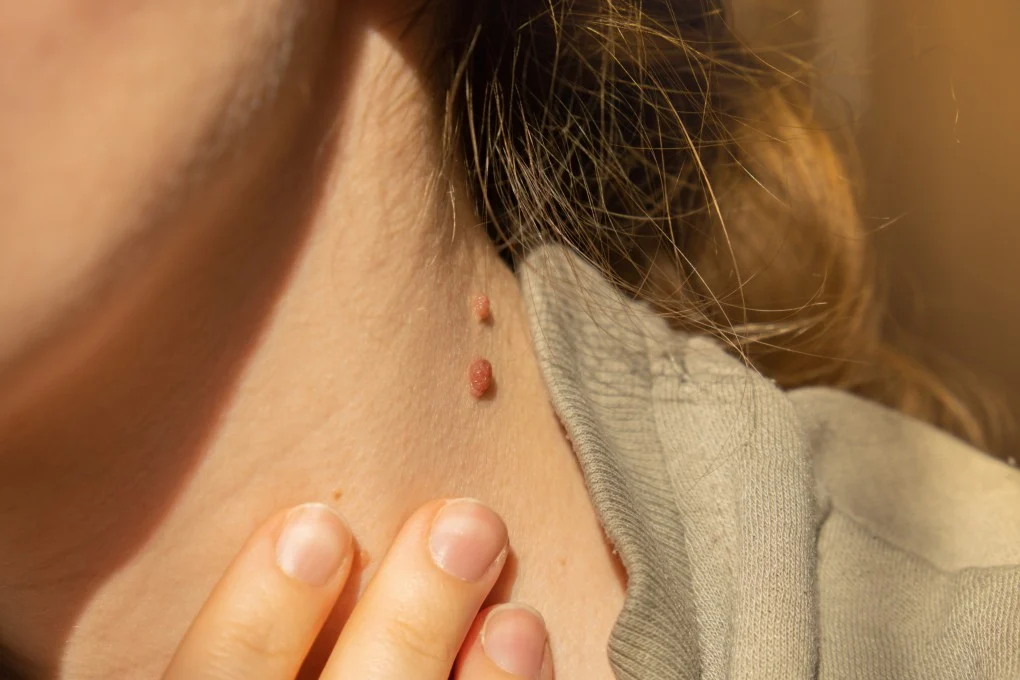
Observing skin changes can help spot cancer spots on skin early. Identify patches with size, color, texture, or shape differences. Check for open, itchy, or bleeding sores. If these symptoms occur, see a doctor.
Cancerous Spots: Types and Causes
Melanoma, BCC, and SCC are common cancer spots on skin known as skin malignancies. Their appearance differs. Watch out for:
Basal Cell Carcinoma
The most common non-melanoma skin cancer is BCC (70%). Many BCC grow slowly over months or years.
Cancer spots on skin commonly develop on sun-exposed areas but can occur elsewhere. Shiny or pearly lumps or scaly pink, red, or flesh-colored skin may emerge. It may heal briefly before inflaming again.
Squamous Cell Carcinoma
About 30% of cancer spots on skin are SCC, a common type of skin malignancy. It can spread quickly, especially on the face, over weeks or months.
SCC is frequent on sun-exposed skin but can arise elsewhere. Red, crusty, scaly, or thick. These areas may bleed, sting, or hurt.
Consult a doctor if you suspect SCC.
Melanoma
Melanoma is rarer than BCC and SCC but more dangerous; if identified late, it spreads swiftly.
Check your entire body, even shaded regions. New or altered moles can cause melanoma. Flat or raised with irregular edges and colours.
Visit your doctor immediately if you suspect melanoma, as it is one of the most serious cancer spots on skin. Nodular melanoma spreads quickly. Early detection matters. A firm, elevated pink, red, or brown mass may emerge. The mass may bleed or crust. Nodular melanoma requires rapid medical attention.
Other Skin Spots to Watch
Noncancerous regions can develop into cancer spots on skin if left unchecked. Watch these:
Many moles are harmless. Hereditary or childhood solar exposure can cause moles. They are dark, black, skin-coloured, or round or oval. Multiple moles increase melanoma risk. Watch for changes.
Dysplastic Naevi
These moles may vary in colour or shape. Many dysplastic naevi enhance melanoma risk. Discuss monitoring with your doctor if many.
Solar Keratosis
Actinic keratoses are flat, scaly pink, red, or skin-coloured patches. Sun-exposed persons over 40 are more likely to have them. These patches can induce SCC if untreated. Doctors can check sunspots.
Hairy Keratosis
Common before 60, these patches are safe. Warts or barnacles are pale brown, orange, or black. From a few to 20 mm.
Protect Your Skin from UV
UV exposure and inadequate skin protection cause most skin cancer. Despite your ignorance, UV harm accumulates.
Protect your skin with these five simple steps:
- Put on a shirt
- Wear sunblock and a hat.
- Seek shade,
- Wear UV-index 3+ sunglasses.
Know Your ABCDEs of Melanoma Detection
An easy way to spot possible melanomas early is by using the ABCDE rule. This rule helps you notice unusual changes in moles and other spots. A is for Asymmetry—one half looks different from the other. B is for Border—irregular, jagged, or blurred edges. C is for Colour—multiple shades or uneven colouring. D is for Diameter—anything larger than a pencil eraser (about 6 mm). E is for Evolving—any changes in size, shape, or symptoms like itching or bleeding. Regular skin checks and knowing the ABCDEs can help catch melanoma early, when it’s easier to treat.
When to See a Dermatologist
Early detection is key to treating skin cancer. If you notice any new or changing spots, make an appointment with a dermatologist. It’s especially important if the spot is painful, bleeds, itches, or doesn’t heal. Even if it seems minor, getting a professional opinion can give you peace of mind. People with fair skin, a history of sunburns, or many moles should consider annual skin checks. Dermatologists can use tools like dermoscopy to examine suspicious spots closely. Don’t wait—early diagnosis can make treatment easier and more successful. Your skin’s health is worth the time.
Effective Treatment for Cancer Skin Peeling at Wall Dermatology
Protect your skin today with Wall Dermatology’s expert care. If you’re dealing with cancer skin peeling, our specialists provide personalized treatments for healing and prevention. Contact us now!
